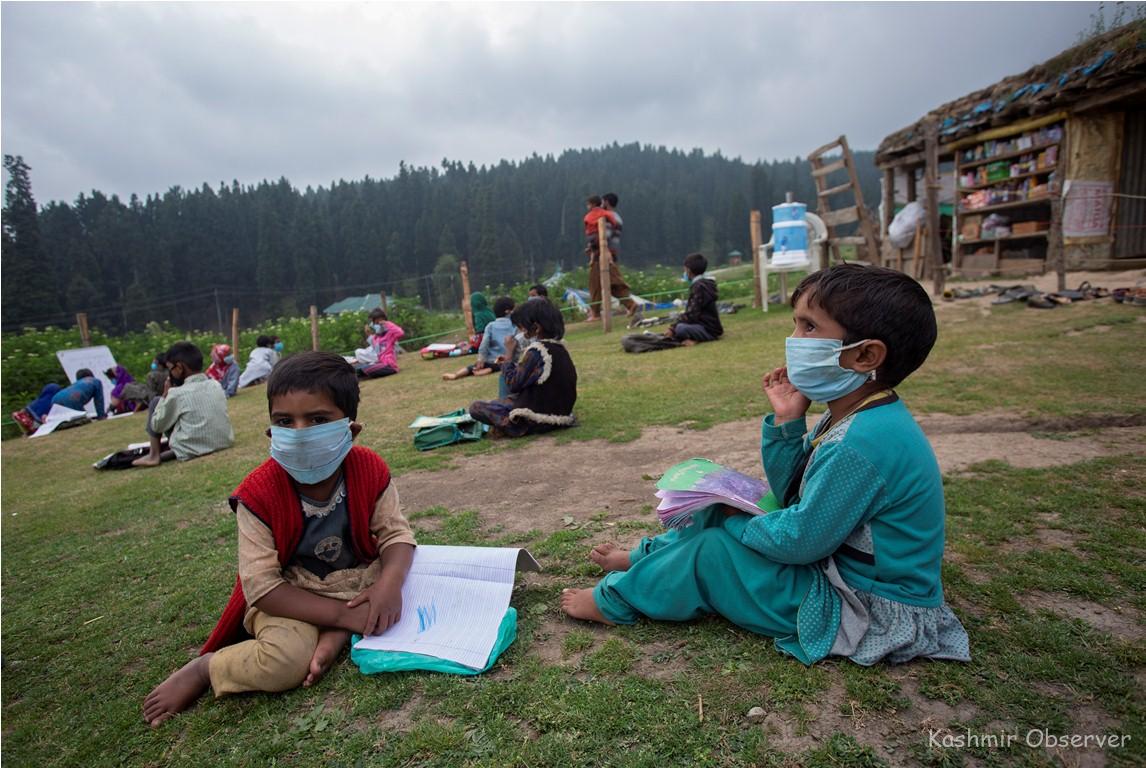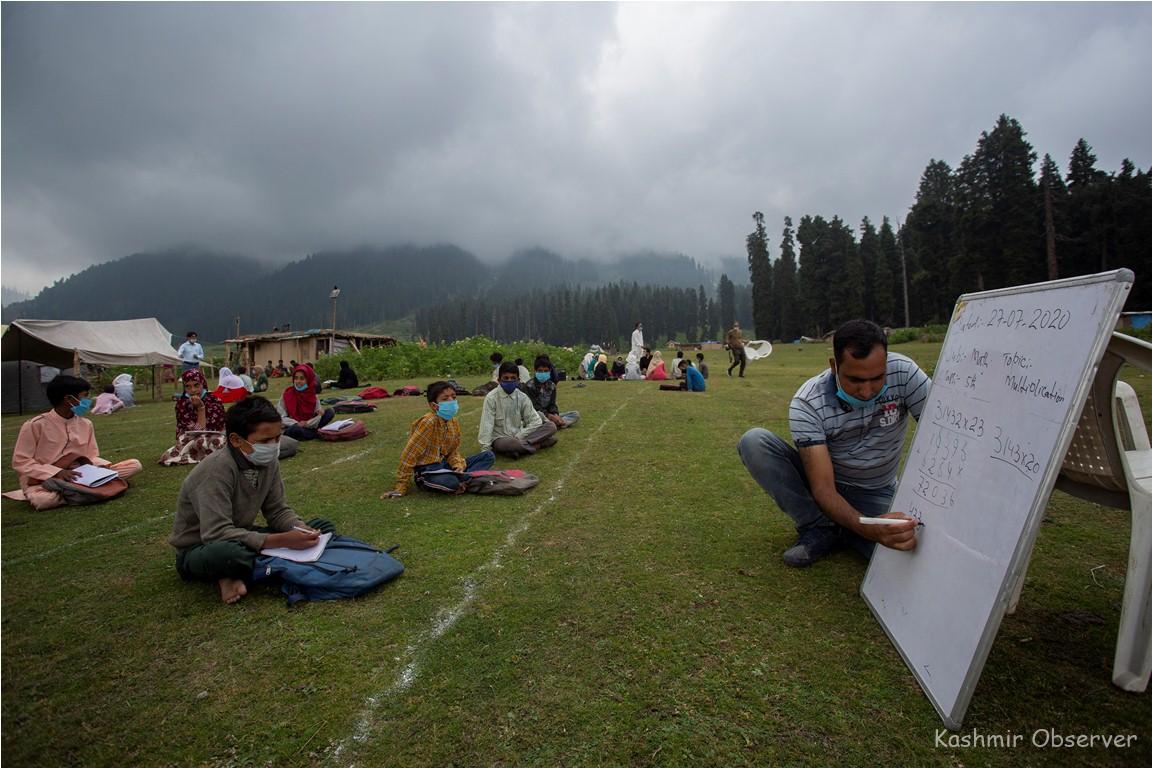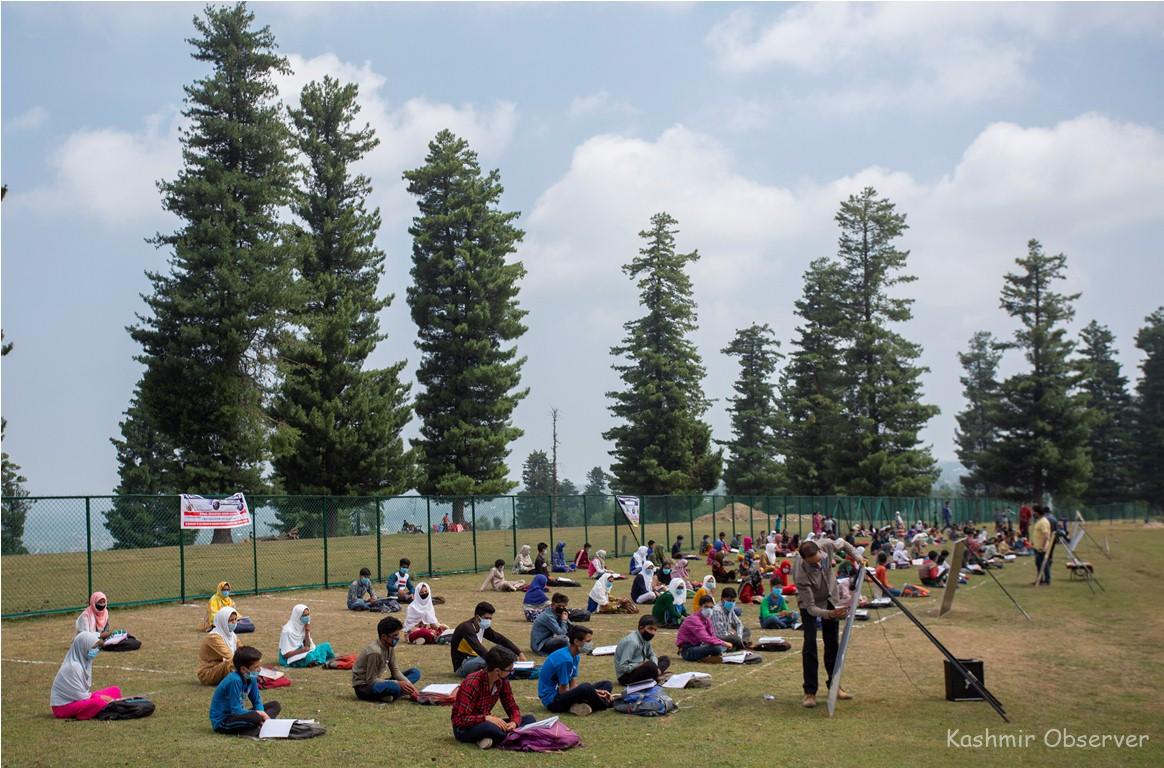
For some lockdown-weary Kashmiri students, a moment of respite came recently when they started attending an open-air school in the boroughs of Budgam. After the striking classroom images made it to social media, many Kashmiri students wondered: “When would we get to attend such schools?”
Photos by Abid Bhat
SITTING crossed-leg on sprawling lush-green ground in the backdrop of towering peaks and pines, some lockdown-sapped children of Kashmir are finally having some school moment after passing through a year-long maddening phase of captivity within four walls of their home.
As part of unconventional campus, they’re attending community school at Khan Sahib area of Budgam—where their eager participation has become a rallying cry for the same model in different parts of the valley.

The community schooling has resumed some campus life in Kashmir, where schools became sealed structures after New Delhi scrapped J&K’s special status last summer.

Even though their teachers are effortlessly marshaling their keen troupes sans sticking to discipline rods, the innocent faces wonder over a slight flutter in their open air school.

At certain point in their classroom moment, all of them turn their heads towards the metallic road, apparently wondering what may have brought a passing jeep to the upper hilly region.
The school is nestled in the lap of Himalayas devoid of the crammed human habitations.

Not enclosed by concrete walls anymore, these children—maintaining social distancing norms—are restarting their education after their community elders with the help of Fatima Bano, Chief Education officer (CEO), and Zonal Education Officers (ZEO), Budgam decided to start this uncanny campus amidst the pandemic in the upper regions of Khan Sahib.

After briefly returning to normalcy, schools in Kashmir were closed with the onset of COVID bringing education to a standstill.
Soon Dr. Asgar Hassan Samoon, Principal Secretary of School Education and Skill Development, advised for online classes through Zoom application, but with slow internet services, it was not feasible in Kashmir, said Mohammad Ramzan Wani, the ZEO.

“In upper belts,” Wani told Kashmir Observer, “a majority of people don’t have android phones. To tackle this problem, we started conducting classes in open.”

According to Wani, seven community classes were set up in Khan Sahib, but as the number of Covid cases increased, with many areas falling under Red Zone, the number trickled to three.
The classes are conducted keeping the safety measures in mind, the ZEO informed.

While the concept of community classes has received a lot of appreciation but there’re many challenges faced by the authorities, teachers, and students.

The unpredictable weather in the upper belts obstructs these classes.
“The weather changes quickly here,” Wani said. “Even though it’s raining now, a few moments later, the sun will be smiling at us.”

But for the children, it has become an uphill task, as they’ve to cover a distance of around 2 km to reach the open space amidst the unpredictable weather.

Since the classes are organized continuously for three hours without any recess, it becomes difficult for the children to sit in the open for such a long time, Wani said.
“The children become restless after some time and the surroundings become a distraction for them.”

The ZEO tried to pitch tents for seamless execution of the classes, but it did not cater to everyone.
Wani also receives many complaints from parents who are worried about their children getting infected from any person coming outside Khan Sahib area.

“Teaching is not everyone’s cup of tea,” Wani said. “And these obstacles just add more hurdles in the process.”

A majority of children coming to the community schools belong to the Gujjars and Bakarwals, the notified scheduled tribes in Jammu and Kashmir.

According to Wani, 80-90 percent of the children are from the scheduled tribes.

Abdul Majeed who belongs to the Gujjar community has volunteered as an Urdu teacher at Khan Sahib’s community school.

“When I saw a picture of a teacher teaching at a community school in Chrar-e-Sharief, I thought why shouldn’t we also start this practice in our area,” said Majeed, a government school teacher.

Majeed started the community classes on a trial basis for one month, and the results were positive.
He then decided to approach the CEO for their support, and the rest is history.

The CEO and ZEO provided whiteboards, sanitizers, and masks for the school, the Urdu teacher informed.

The authorities also pay a visit from time to time to look after the progress and provide help if needed, Majeed said.

On being asked about the comparison between the normal schools and the community schools, Majeed believes that the facility provided in normal schools—like a laboratory grooming students practically—is missing in the latter.

But that does not stop these teachers from leading from the front.
The educators are hardworking, and they help out students in every way possible, said Mushtaq Ahmad, the Zonal Resource Person (ZRP) at Khan Sahib.

Recently, when Mushtaq saw a picture of a community school in Lolab valley, tweeted by Asgar Samoon, he was inspired to start a community school in his area.
The teachers came up voluntarily, he said, and helped to set up the school.

During these tough times, the community schools are creating awareness amongst the children about COVID and how to prevent the spread of the virus.
“The children are encouraged to wash their hands regularly,” Mushtaq said. “They’re also made to follow social distancing norms, while attending the classes.”

Mushtaq who provides academic support to the community schools leaves his house at 7:30 am and goes to various centers to assist. He has a group of members whose hard work has helped the schools to flourish in tough times.
“Samaritans like Muzaffar Masroor, Irfan Bashir, Nisar Ahmad Khan, Mohammad Iqbal are doing exemplary work, even better than me,” said the modest ZRP. “Nothing would have been possible without their help.”

On being asked about the support provided by the ZEO, Mushtaq said, “Mohammad Ramzan Wani is the backbone of the community schools. He is empathetic towards the teachers and keeps a watch on all the activities. Because of him, the enrollment in the schools has increased.”

After abrogation of Article 370 last August, children in Kashmir had resumed their schools on March this year, when they were faced with another lockdown.
But in these uncertain times, the community schools have indeed become the silver lining for the lockdown-weary Kashmiri children.
Follow this link to join our WhatsApp group: Join Now
Be Part of Quality Journalism |
Quality journalism takes a lot of time, money and hard work to produce and despite all the hardships we still do it. Our reporters and editors are working overtime in Kashmir and beyond to cover what you care about, break big stories, and expose injustices that can change lives. Today more people are reading Kashmir Observer than ever, but only a handful are paying while advertising revenues are falling fast. |
| ACT NOW |
| MONTHLY | Rs 100 | |
| YEARLY | Rs 1000 | |
| LIFETIME | Rs 10000 | |











